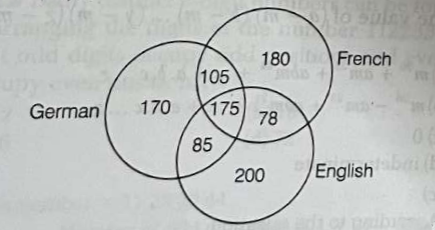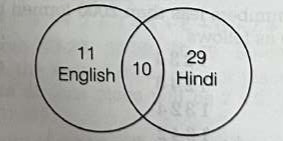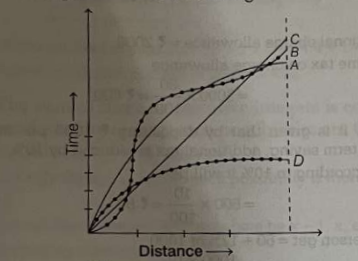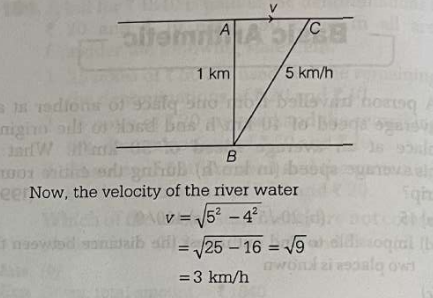Explore UPSC Prelims Topic Wise Questions on Basic Numeracy, specifically focusing on Elementary Algebra, Sets, and Functions. This comprehensive resource offers structured practice material designed to enhance your understanding and proficiency in these foundational mathematical concepts. Delve into a wide range of questions meticulously curated to align with the UPSC Prelims exam pattern, ensuring thorough preparation and confidence on exam day. Whether you’re a beginner seeking to build a strong mathematical base or aiming to refine your skills, this collection caters to diverse learning needs. Sharpen your problem-solving abilities, grasp key principles, and reinforce your knowledge through systematic practice. Elevate your UPSC Prelims preparation with targeted exercises that cover essential topics in Basic Numeracy, empowering you to approach the exam with competence and readiness.
Contents
- 1 Q1. The value of (a – m) (b – m) … (y – m) (z – m) is (1995)
- 2 Q2. If A = x 2 – y2,B = 20 and x + y = 10, then (1996)
- 3 Q3. In a group of persons travelling in a bus, 6 persons can speak Tamil, 15 can speak Hindi and 6 can speak Gujarati. In that group none can speak any other language. If 2 persons in the group can speak two language and one person can speak all the three languages, then how many persons are there in the group? (1997)
- 4 Q4. A survey was conducted on a samples of 1000 persons with reference to their knowledge of English, French and German. The results of the survey are presented in the given venn diagram. The ratio of the number of the persons who do not know any of the three languages to those who know all the three language, is (1997)
- 5 Q5. In a family, a couple has a son and daughter. The age of the father is three times that of his daughter and the age of the son is half of his mother. The wife is nine years younger to her husband and the brother is seven years older than his sister. What is the age of the mother? (1998)
- 6 Q6. There are 50 students admitted to a nursery class. Some students can speak only English and some can speak only Hindi. 10 students can speak both English and Hindi. If the number of students who can speak English is 21, then how many students can speak Hindi, how many can speak only Hindi and how many can speak only English? (1998)
- 7 Q7. Distance time graph in respect of a race among four persons is shown in the given figure. Consider the following statements in this regard (1996)
- 8 Q8. The average monthly income of person in a certain family of 5 persons is 1000. What will be monthly average income of person in the same family if the income of one person increased by 12000 per year? (1997)
- 9 Q9. A boat which has a speed of 5 km/h in still water crosses a river of width 1 km along the shortest possible path in 15 min. The velocity of the river water (in km/h)is (1997)
- 10 Q10. Out of the three annual examination, each with a total of 500 marks, a student secured average marks of 45% and 55% in the first and second annual examinations. To have an overall average of 60%, how many marks does the student need to secure in the third annual examination? (1998)
- 11 Q11. If 15 pumps of equal capacity can fill a tank in 7 days, then how many extra pumps will be required to fill the tank in 5 days? (1998)
- 12 In case you still have your doubts, contact us on 9811333901.
Q1. The value of (a – m) (b – m) … (y – m) (z – m) is (1995)
(a)m 26 + am 25 + abm 24 + … + a.b.c… z
(b) m²6– am25 + abm24 + … + a.b.c… Zі
(c) 0
(d) indeterminate
Ans. (c)
According to the question,
(a – m) (b – m) (c – m)…(m – m)…(z – m) = 0 [since, m − m = 0]
Q2. If A = x 2 – y2,B = 20 and x + y = 10, then (1996)
(a) A is greater than B
(b) B is greater than A
(c) A is equal to B
(d) It is not possible to compare A and B as the data provided is inadequate
Ans. (d)
According to the question,
A = x²- y² = (x + y) (x – y) = 10(x – y)
B=20 [unknown variable is more than equation given) So, it is not possible to compare A and B, as the value of x and y is not known.
Q3. In a group of persons travelling in a bus, 6 persons can speak Tamil, 15 can speak Hindi and 6 can speak Gujarati. In that group none can speak any other language. If 2 persons in the group can speak two language and one person can speak all the three languages, then how many persons are there in the group? (1997)
(a) 21
(b) 22
(c) 23
(d) 24
Ans. (c)
Let 2 persons who can speak two language, speaks Tamil and Hindi.
Number of persons who speaks only Tamil=6-2-1-3
Only Hindi = 15-2-1 = 12
Only Gujarati = 6-1=5
Total number of persons in the group = 3+12+5+2+1=23

Q4. A survey was conducted on a samples of 1000 persons with reference to their knowledge of English, French and German. The results of the survey are presented in the given venn diagram. The ratio of the number of the persons who do not know any of the three languages to those who know all the three language, is (1997)

(a) 1/27
(b) 1/25
(c) 1/550
(d) 175/1000
Ans. (b)
According to the question,
Total number of persons who know only English or French or German = 170+180+200= 550
Number of persons who know any two languages = 105+85+78=268
Number of persons who know all the three languages = 175
Number of persons who know any of the language =550+268 + 175 =993
Number of persons who do not know any of the language = 1000-993 =7
Required ratio = 7/175 = 1/25
Q5. In a family, a couple has a son and daughter. The age of the father is three times that of his daughter and the age of the son is half of his mother. The wife is nine years younger to her husband and the brother is seven years older than his sister. What is the age of the mother? (1998)
(a) 40 уг
(b) 45 уг
(с) 50 уг
(d) 60 уг
Ans. (d)
Let the mother’s age be m yr. The age of father = (m + 9) yr According to the question,
The age of son =m/2 yr
The age of daughter = ((m/2)-7) yr
Now, according to the question,
(m+9)=3((m/2)-7) ⇒ m +9=(3m – 42)/2
⇒ 2m+18=3m-42
⇒ m = 60 уг
Q6. There are 50 students admitted to a nursery class. Some students can speak only English and some can speak only Hindi. 10 students can speak both English and Hindi. If the number of students who can speak English is 21, then how many students can speak Hindi, how many can speak only Hindi and how many can speak only English? (1998)
(a) 21, 11 and 29 respectively
(b) 28, 18 and 22 respectively
(c) 37, 27 and 13 respectively
(d) 39, 29 and 11 respectively
Ans. (d)
According to the question,

Number of students who speak only English = (Number of students who speak English Number of students who speak both Hindi and English) = 21-10 = 11
Q7. Distance time graph in respect of a race among four persons is shown in the given figure. Consider the following statements in this regard (1996)

1. ‘A’ stood first in the race.
2. ‘ C’ led all the way.
3. ‘D’ ran faster than others in the later part of the race.
Of these statements
(a) 1 and 3 are false and 2 is true
(b) 1 and 2 are false and 3 is true
(c) 1 and 3 are true and 2 is false
(d) 1 is true and 2 and 3 are false
Ans. (b)
Statement (1) is incorrect as ‘A’ did not come first in the race; ‘D’ did, as it took less time than the others. Statement (2) is false as ‘C’ did not lead throughout the race. Statement (3) is accurate as ‘D’ started slower but ultimately ran faster than the others later in the race. Therefore, Statements (1) and (2) are false, and Statement (3) is true.
Q8. The average monthly income of person in a certain family of 5 persons is 1000. What will be monthly average income of person in the same family if the income of one person increased by 12000 per year? (1997)
(a) ₹1200
(b) ₹1600
(c) ₹2000
(d) ₹3400
Ans. (a)
According to the question,
Total income of the family per month = 5×1000=5000/month
Increased amount=12000 per year.
i.e., 12000/12 = ₹1000 per month
Now, total amount of the family = 5000+1000 = 6000
So, the average income of the one person in the family = 6000/5 = ₹1200
Q9. A boat which has a speed of 5 km/h in still water crosses a river of width 1 km along the shortest possible path in 15 min. The velocity of the river water (in km/h)is (1997)
(a) 1
(b) 3
(c) 4
(d) √41
Ans. (b)
The speed of the boat along the shortest possible path
A = 1/(15/16) = 4 km/h

Q10. Out of the three annual examination, each with a total of 500 marks, a student secured average marks of 45% and 55% in the first and second annual examinations. To have an overall average of 60%, how many marks does the student need to secure in the third annual examination? (1998)
(a) 450
(b) 400
(c) 350
(d) 300
Ans. (b)
According to the question,
Let the average marks in third annual examination be x. Total marks Marks in (first examination + second examination + third examination)
3(60)(500/100) = (45/100) (500)+[55/100](500)+[x/10] (500)
180 = 45+55 + x
x = 80
Marks in third annual examination = (80/100)(500) = 400
Q11. If 15 pumps of equal capacity can fill a tank in 7 days, then how many extra pumps will be required to fill the tank in 5 days? (1998)
(a) 6
(b) 7
(c) 14
(d) 21
Ans. (a)
Number of pumps required to fill a tank in 7 days = 15
Number of pumps required to fill a tank in 1 days
= 15×7=105
Let the extra pumps required be n.
Now, number of pumps required to fill the tank in 1 day = (n+15)5
In case you still have your doubts, contact us on 9811333901.
For UPSC Prelims Resources, Click here
For Daily Updates and Study Material:
Join our Telegram Channel – Edukemy for IAS
- 1. Learn through Videos – here
- 2. Be Exam Ready by Practicing Daily MCQs – here
- 3. Daily Newsletter – Get all your Current Affairs Covered – here
- 4. Mains Answer Writing Practice – here

